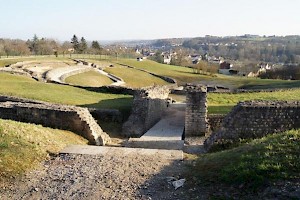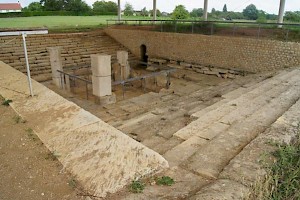Argentomagus
Q2860982Argentomagus: important settlement of the Bituriges, modern Saint-Marcel.
Oppidum

The oppidum of Argentomagus ("silver market") was an important settlement in the southern part of the civitas of the Bituriges, some hundred kilometers south of their capital Avaricum (modern Bourges). Consisting of a more or less square platform with a surface of about twenty-seven hectares, it was the second-largest oppidum in the region of Berry.
On the southern side, the rocks along the river Creuse (which was bridged) offered the town impressive natural defenses; in the east, the steep slope towards the source of the Mage was equally easy to defend, while the western valley was overlooked by a double wall and a ditch.
In the northwest, the remains of the wall and the only entrance are still visible. They were protected by a ditch with a length of about eighty meters that had to keep enemies out.
Inside the oppidum, Gallic structures and traces are still visible. Among the objects that have been excavated are bronze colanders, bronze Nauheim fibulae (which are Celtic), other fibulae made of iron, bracelets, pearls, glass, amber, and bronze buckles. The can all be dated to the second and first centuries BCE.
Roman Empire

The town became - apparently without violence - part of the Roman Empire when Julius Caesar conquered Gaul (58-50 BCE). After a slow start, in which pre-Roman traditions were continued, Argentomagus became more Roman and more important, being the place where four important roads came together. To the north were towns like Avaricum and Cenabum (Orleans), to the east were the valleys of the Saône and Rhône, the road to the south was used to travel to Vesunna (Périgieux) and Aginnum (Agen), while in the west were Limonum (Poitiers) and the ports of the Atlantic Ocean. In the course of the second century, the city became quite important.
One of the buildings from Roman Argentomagus is the bathhouse. The floor has been excavated, together with two pieces of sculpture and the capital of a column that appears to have been part of a gate that gave access to the swimming pool. This capital can be dated to the second half of the second century CE.
In the western part of the town was a theater. With this monument, Argentomagus could claim to be one of the more important Biturigian town - after Avaricum itself, of course. After the year 150, the theater, which had apparently become too small for the increasing population, was demolished and replaced by a bigger one. It was still in use in the third century.
Late Antiquity
During the persecution by Emperor Valerian (r.253-260), Argentomagus witnessed the martyrdom of a Christian named Marcellus. According to the Notitia Dignitatum, a document that describes all offices in the Roman Empire, there was an arms factory in fourth-century Argentomagus. This is quite remarkable, because the town appears to have had no fortifications.